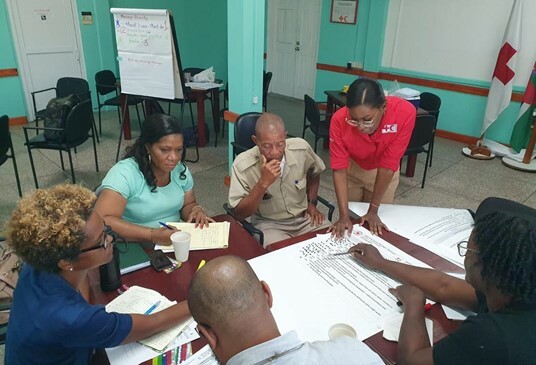
A new tool, the Handbook on Disaster Law Reform: A Guide for Domestic Authorities provides an eight-step process to guide lawmakers embarking on legal review processes relating to disaster risk management.
Guidelines for stronger disaster laws
Laws, policies and plans underpin all aspects of disaster risk management, forming an often-invisible foundation that protects and prepares communities around the world.
Despite significant improvements in recent decades, many countries still need to strengthen their disaster laws to effectively manage the risks and impacts of disasters. It is against this backdrop that, through over twenty years of research and practice around the world, the International Federation of Red Cross and Red Crescent Societies (IFRC) Disaster Law team has developed extensive guidance on how domestic laws, policies and plans can best support disaster risk management (DRM).
This body of recommendations has recently been consolidated into a single guidance document, the Disaster Risk Governance Guidelines: Strengthening Laws, Policies and Plans for Comprehensive Disaster Risk Management (the Guidelines). The Guidelines are a tool to support the lawmakers and government officials – at all levels – responsible for the development and implementation of DRM.
Meeting a continued need for enhanced legal frameworks
The development of the Guidelines is timely, given that the recent Mid-Term Review of the Sendai Framework found that progress towards strengthening disaster risk governance has been varied and that there is a continued need to enhance legal frameworks. Therefore, although states continue to make significant progress towards strengthening their domestic disaster laws, more needs to be done.
The Guidelines can guide DRM legislative review processes in terms of the recommended contents and features of DRM legal and policy frameworks, contextualised to a particular country context.
However, they do not provide guidance on how DRM legislative review processes can be conducted to ensure the comprehensive, all-of-society approach vital to support the effective implementation of DRM in practice.
To fill this gap, IFRC Disaster Law has developed the Handbook on Disaster Law Reform: A Guide for Domestic Authorities (the Handbook).
An eight-step disaster law review process
The Handbook provides guidance on how to run an effective and inclusive legal review process that harnesses the knowledge and experience of a broad range of actors and stakeholders to develop strong legal arrangements for disasters.
While legal review processes will vary depending on a specific country context and legal system, the Handbook broadly identifies eight key steps that can support government decision-makers and parliamentarians who are planning or engaging in the development or review of disaster laws and regulations.
Step 1: Establishing an institutional structure
Identify which government entity will lead the review and establishing a multi-sectoral working group to oversee the review.
Step 2: Context analysis
Analyse the country's disaster risk profile, legal landscape and existing arrangements for DRM.
Step 3: Planning the review process
Make a clear plan for the review process that addresses objectives, timing, activities, roles and responsibilities, and budget.
Step 4: Legal analysis
Map and analyse existing disaster related laws to identify strengths, weaknesses and gaps using the Guidelines.
Step 5: Stakeholder consultations
Conduct extensive consultations with government and non-government actors to understand practical challenges.
Step 6: Preparing a report
Draft a report summarising the key findings from the review and providing a set of recommendations; then publish and disseminate the report.
Step 7: Drafting and enacting legal instruments
Liaise with government lawyers to draft a new legal instrument (or amendments to existing instruments) and advocate for their adoption by parliament or the executive branch of government.
Step 8: Planning monitoring and implementation
Reconvene the working group to plan and monitor implementation of the new legal instruments.
The Handbook also includes a series of case studies from Fiji, Honduras and Malawi showcasing successful, government-led disaster law reform processes to share experiences and lessons learned on the ground.
Discover IFRC’s Disaster Law resources
IFRC Disaster Law’s website is home to a plethora of disaster law resources, including regional, sub-regional and country profiles from across the world, tools and research materials developed by IFRC Disaster Law, as well as Disaster Law online training. The website is also home to the Disaster Law Database, the world’s largest collection of materials on disaster law.
This blog post was originally featured on PreventionWeb.